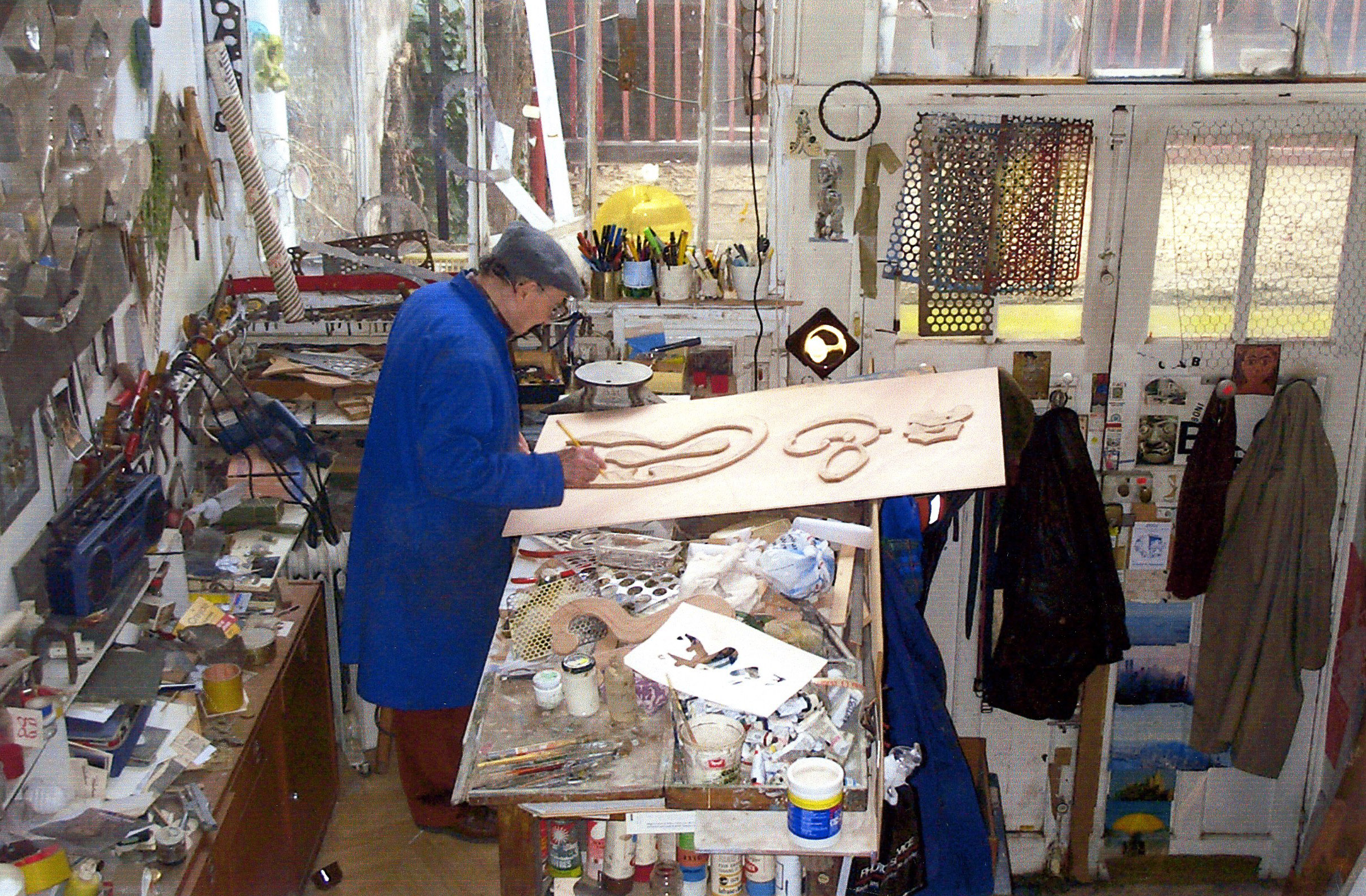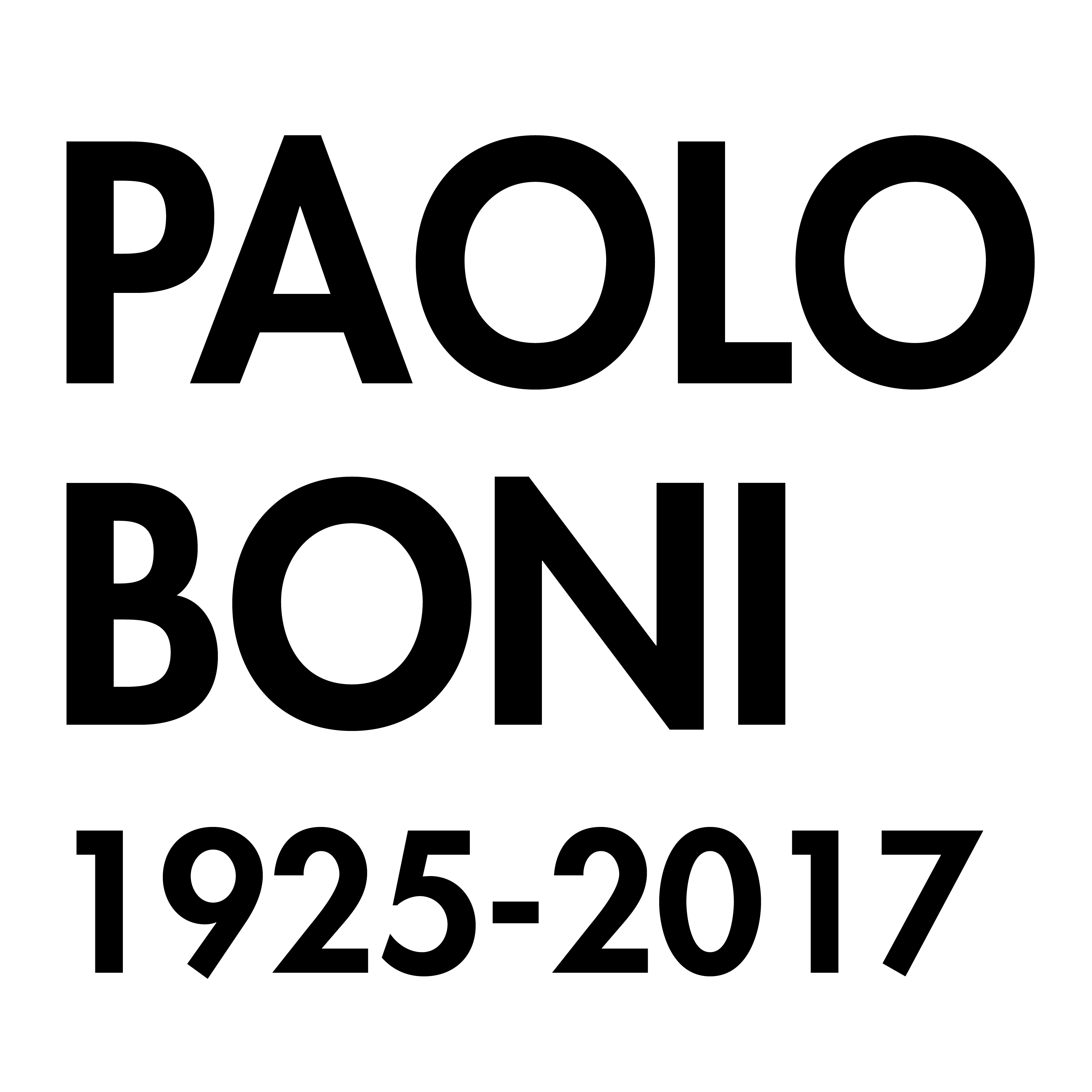
Paolo Boni in his workshop at the Impasse du Rouet in Paris © Cuchi White
Giorgio Agnisola
paule gauthier
michelangelo masciotta
georges perec
Vanessa Noizet
par Giorgio Agnisola
THE FANTASTIC AND THE MECHANICAL
Paolo Boni has an inborn vocation to abstraction, or more precisely to abstract construction, implying as well the limits of manual expression, of the mechanics of relations which appear principally in the dimension of imaginary and poetic space.
Boni’s art seems to have a double meaning or appearance, of poetry and mechanics, of intention and impulsive drive, of lucid formal articulation with an emotive emphasis of image.
A “conditioning” that refers to the constructivist and cubist lesson (to the Russians and, above all Magnelli) without ignoring the best known surrealistic and metaphysical testimonies, but which possesses an incontestably personal mark (besides the singularity of technical means that characterise his work), a style that we could define as romantic with a certain mediterranean inclination as it were, within the severity of careful structural acquisitions.
That Boni’s expression comes authentically from his personal experience, is also confirmed by the artisanal limits implicit to his art.
Boni is above all an extraordinary artisan, who has assimulared and grown throughout the years. The most original aspects of his work, the most stimulating in the presence of an openly creative relation to fantasy and matter in the long exercise of his trade, have been watched over daily in the refinement of expression and tecnique.
In reality his art begins with a precise relationship to matter (the material), although in the end material research is not his aim.
Giorgio Agnisola, Extract from the text of the book Paolo Boni Il Fantastico e la Mecanica. Traduced from italien.
by Paule Gauthier
We have written about the meaning of Boni’s work that he had been struck by the fragmented landscapes of his province of birth, in sum by the physical character of the place. We should see it as a more universal shape, because for him, feelings and atmosphere came from the same source.
If he reduced life to its tactile and visual properties, in this he juxtaposed the flow of time
and the aspect of being. The asperities and violences fade away in melody, or bring the
vehemence of opposed currents. Yet if we consider his work as a whole, it is balance
that imposes itself.
Paule Gauthier, Excerpt from the magazine Cimaise
by Michelangelo Masciotta
Boni found original solutions in each discipline he practised: painting, sculpture, engraving, or, at the confluence of diverse forms of art, when he elaborated this highly personal form of expression that were his metallic bas-reliefs.
Painter, he replaced by subtle modulations the violent oppositions, he managed to find, to substitute them from simple and formal connections to intimate and deep ones.
Sculptor, he made himself nature’s confidant without letting himself fall into anthropomorphism nor give into the respect to outside appearances. It truly was about a more secret nature, that does not give itself at first glance but manifests itself, by a push towards the outside, or below visible objects, at the edge of plastic boldness.
Engraver, he gouged planks until he pierced them, the print being subject to a pressure so strong that it risked being crushed. He thus obtained on the paper some high reliefs and some deep crevices between which the signs flow as if lifted by ravine waters that course and wave through it, fast, at the feet of mountains.
His world is today the one of the unpredictable: states of mind, interior duration, reminiscences, fantasy and mirage of solitude, transposition of lights, equivalences or contrasts of feelings, reductions or broadening of space, rhythm of wholeness and emptiness, those are now the themes to which his work organises and renews itself.
Michelangelo Masciotta, Excerpt from an exhibition’s presentation
by Georges Perec
PAOLO BONI, THE MECHANIC OF THE IMAGINARY
The first emotion you feel when looking at Paolo Boni’s work is one of combat: a fight between the painter and his painting, a fight against texture, against shapes, a fight against the initial space of the painting, its frame, this wooden chassis of pulled canvas, and at first glance we might believe that containing the stored energy is an impossible task, as if the painter had attempted to compress its strength for a brief moment, tensions gathering that seem to eventually kindle an explosion.
The layout of these basic elements incessantly brought from one canvas to the next, their superposition, disarticulation, their game produce these strange optical illusions that seem created by a mechanic of the imaginary, who would seek at the bottom of forges, foundries and workshops, the fabric of dreams themselves.
Georges Peres, Excerpt from a presentation at the Fiac.
by Vanessa Noizet
IMAGINARY SPACES. FRAGMENTS FOR PAOLO BONI
“I cannot imagine a better tribute to him, now that his work has come to an end, than to reject the idea of an end point in order to see in the ventures that were his own, and even in his later productions, a perpetual beginning, something akin to an endlessly renewed introduction […].” 1
Long before it appears in the eyes of the author, reader or viewer as the final product, a finished piece limited to the boundaries of the page, canvas, metal plate, block of stone or wood, writing, and indeed painting, sculpture or engraving, firstly manifests itself as an active and operational thought in motion that the commentator then perceives and explains in order to “find the “way-in”2. In the case of Paolo Boni, a painter born near Florence in 1925 but installed in France since 1954, the way-in has really yet to be sought and discovered since the artist’s work has thus far remained somewhat confidential.
This last statement, however, is not without paradox or ambiguity. On the one hand because Paolo Boni continued to exhibit until the beginning of the twenty-first century, individually and collectively, in Europe and in the United States (curious readers can find the names and dates of some of these events in the catalogs published on these occasions). On the other hand, his art was noticed very early on by artists, writers, historians, critics and museum curators, all of whom perceived his singularity in the context of a declining “School of Paris” and a particularly divided French art scene.
The painter Gino Severini, a member of the futurist group in the 1910s, wrote a preface for Paolo Boni’s first Parisian exhibition in 1954, organized at the Galerie Voyelle. Herta Wescher and Richard S. Field, the authors respectively of reference books on collage and engraving, also promoted Boni’s productions in fine articles, as did critics Simone Frigerio and Jacques Lepage, who regularly contributed to some of the most important French journals during the Cold War: Art et Architecture d’aujourd’hui, Les Lettres françaises, etc. Writers Michel Butor, Maurice Roche and Georges Perec, who were close to Paolo Boni, also collaborated with the artist compiling collections of prints where the text and the images are cleverly combined, such as for example, Chronique des Astéroïdes, Ça ! ou de Métaux, on the one hundred and thirty-five copies planned, only a few copies were printed in 1985.
However much this short review of the critical reception of Paolo Boni’s work tells us about the artist’s circle of friends, his professional network and the contemporary spread of his work, it cannot in any way obscure the richness and significance of the work itself. This is why many texts highlight its truly independent and original character, based on the pictorial and sculptural research initiated by Paolo Boni in the forties, which he continued a short time later with a series of inventive engraved experiments which Alfonso Ciranna classified as “graphisculptures”3 in 1970.
Unlike traditional engraving techniques, Paolo Boni’s process does not involve the successive removal of material. Instead of resorting to subtraction, chiseling or an acid bath, Boni shapes the metal with additions of “pieces of cut metal”, “riveted” on the original matrix 4 . After completing his first portraits and painted landscapes, praised at the time by Gino Severini, who saw in them the combined influence of “modern” French painters and the Italian Primitives – need we recall that Paolo Boni’s native village of Vicchio di Mugello was also the homeland of Giotto di Bondone? – Boni’s productions lent material form to the artist’s essentially formal concerns, themselves nourished by his simultaneous practice of these different arts.
In the same way as Paolo Boni’s sculptural and graphic essays, dominated by his taste for flat surfaces and reliefs, his paintings in the nineteen-sixties gradually gained in precision. From this period onwards he favored juxtapositions and superimpositions of shapes and preferred flat surfaces with sharp contours to brushstrokes and ostentatious impasto, without ever denying the artworks’ materiality in any way. While his first paintings were inspired by the discovery of so-called fauvist and cubist painters with their presentation of highly geometrical volumes, subsequent pieces rather seem to demonstrate Paolo Boni’s interest in the work of Fernand Léger, his contrasts of forms and great plasticity. Léger’s art, which displays a certain fascination for the industrial world, goes as far as intertwining the specificities of human bodies, objects and machines. However, the art of Boni, the inventor of a particular kind of relief engravings, suggests rather more a taste for cosmic spaces and aeroplanes, the dreams and utopias they embody, and the territories they offer to the imagination. The work of Paolo Boni, as it appears to us today, a few months after the artist’s passing, is in itself a personal world which escapes the contemporary artistic quarrels and the “agonizing problems of the figurative and the non-figurative, the abstract, the geometric or not, or Tachisme […]”5. Neither abstract nor figurative, since he is precisely one and the other, his partially unveiled art prevails, while Paolo Boni himself has escaped into imaginary spaces.
